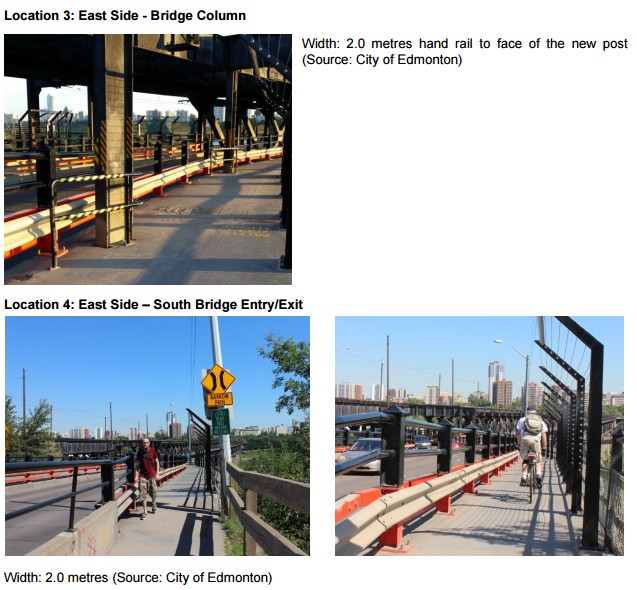A safety audit of the operation of the High Level Bridge for walking and cycling has just been released. You can view the full report online. There are many good recommendations in this safety report, including:
- enhancing the barriers between the roadway and the paths (ideally in a way that minimizes splashing from cars, ice build-up, and wind), both on the bridge itself and some of the approaches,
- better marking hazards,
- removing barriers such as signs and posts and some redundant fencing,
- fixing uneven surfaces,
- installing rub rails,
- improving lighting,
- widening the approaches and improving sightlines at intersections
One-way operation is not supported
One recommendation that we do not support at this time, however, is the safety audit's recommendation to make any of the paths one-way.
Edmonton claims it wishes to promote active transportation. Placing further barriers to active transportation belies this claim.
Mandated one-way operation would further reduce capacity on the High Level Bridge: a problem now, and in the future if we wish to encourage more people to walk and bike. It would also make the bridge much more difficult to use, requiring long and dangerous traverses.
Have you seen trucks, trailers, or buses rolling over this curb at 109 St and Saskatchewan Drive? Let us know.
Posted by Edmonton Bicycle Commuters Society on Wednesday, August 17, 2016
The City should be looking at solutions that improve the conditions, not jump to rash, anti-solutions that address one problem by making conditions worse.
First, the City should monitor usage and safety issues on the bridge, comparing them to statistics from before the suicide barriers were erected.
We collected many self-reported anecdotes, mostly when all traffic was routed to the east side. These are not scientific numbers. The City needs to collect robust numbers and compare them to pre-barrier baselines. Now that both sides of the bridge are open again, if the injury rate hasn't changed significantly from before the barriers were installed, is there really urgency to change the operation of the bridge?
If the City is able to collect data demonstrating that there continues to be an unacceptably high injury rate, and urgent changes are needed, we may be supportive of limited one-way operation, but only as a near-term mitigation method in conjunction with other changes, potentially with narrowly-defined hours and direction (e.g. east side operates as northbound in the AM peak, southbound in the afternoon peak, and unrestricted otherwise).
Improve intersections, irrespective of other changes
One change that should happen before any changes to travel direction on the bridge is improvements to crossings at both the north and south ends of the bridge. At the least, without any dramatic or expensive infrastructure changes, light signal timings could be altered to allow pedestrians and cyclists to cross the intersection in one phase, rather than multiple phases. There already exists a phase on the south side when no pedestrians are allowed to cross in any direction. There could also be a phase where no cars are allowed to move in any direction, but pedestrians and cyclists could cross in every direction (and clear the intersection much more rapidly).
This improvement, which still falls far short of more substantial improvements to the intersections, would improve safety and recognize the 3500 daily pedestrian and cycling users as more than just interlopers, ducking between turning cars and taking refuge on narrow concrete islands.
Additionally, we know that one of the best ways to influence behaviour (and encourage "desireable" behaviour) is through design. Enforcing one-way operation of the High Level Bridge paths would be extremely difficult, at best, and even more challenging if the City simultaneously maintains the many barriers between the west and east sides. By improving the intersections and making them easier to traverse, many people would opt to use the west side of their own accord, reducing pressures on the east side (and possibly any potential need to make it one-way).
Committee Meeting
City administration's report to committee, which talks about "solutions to make the pathways more cyclist and pedestrian friendly," lists one-way operation under "further investigation" and clarifies that "prior to making any further changes to the current condition, Administration will continue to engage the public to review options to enhance the operation of the two sidewalks/shared-use paths."
The City hosted a meeting with over a dozen stakeholders in August to review the draft safety audit. The consensus in the room was that one-way operation was not currently an acceptable option.
Finally: the committee report lists metrics, targets and outcomes. We are disappointed that none of the metrics consider public health or user safety. We strongly support suicide prevention measures and stronger mental health supports for Edmontonians. Thit is not a mutually exclusive goal from increased active transportation: in fact, the two are complimentary. If additional barriers to active transportation results in fewer people choosing to walk or bike, or indeed in direct injuries, that information should be captured in the City's metrics.
The Urban Planning Committee meets on September 14 to discuss this report. You can request to speak to the committee, or contact your councillor directly.



